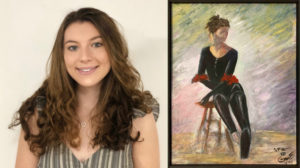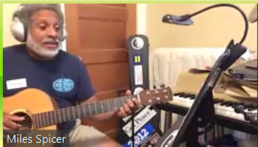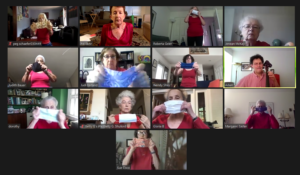What I Learned as an Intern During a Time of Pandemic
 This painting was painted by and gifted to me by my grandma. This past summer it served as a constant reminder to me of how art allows us to express ourselves and why Arts for the Aging’s work is so important.
This painting was painted by and gifted to me by my grandma. This past summer it served as a constant reminder to me of how art allows us to express ourselves and why Arts for the Aging’s work is so important.
What I Learned as an Intern During a Time of Pandemic
By Mira Dwyer
Back in early March, I sat in my college dorm room interviewing with Arts for the Aging about a potential opportunity to intern during summer 2020. As we chatted, I sat looking at the painting from my grandma that was hanging in my room and knew it was an opportunity I wanted to pursue. Throughout my life, art has been something that has drawn me closer to other people, whether it be through photography, music, or jewelry making. I also have a professional interest in marketing and communications, so the alignment of an arts-focused organization that needed help with communications and social media was an exciting opportunity. When I first realized my internship was going to be virtual, I was a bit bummed. I wasn’t going to see my coworkers in person, I wouldn’t be able to attend live programs, and I’d be doing work out of my childhood bedroom. Little did I know all these factors that seemed like disappointments ultimately enhanced my ability to communicate the importance of Arts for the Aging.
About halfway through my internship, while I was creating social media content and website updates , I attended one of Arts for the Aging’s new pandemic-resilient online workshops, with teaching artist Wall Matthews. As he sang using Zoom to older adult participants, many of whom were in extreme isolation due to the pandemic, he began substituting their names into the chorus of the song to make the program more personable. I watched as one senior, who had been quiet for most of the program, light up as Wall Matthews sang her name. I realized that if I had been feeling isolated in quarantine, with my family and two joyful dogs, then to seniors at high risk and often with less access to socialization, moments like these made all the difference in their days.
Stories like these are compelling in understanding and imagining the power of creative aging—especially when safe social interaction with seniors is simultaneously so difficult, yet so necessary.
In addition to attending online workshops, Zoom also gave me the ability to meet more of Arts for the Aging’s teaching artists, as they would sometimes pop into our weekly online team meetings. When teaching artist Nancy Havlik introduced herself and talked about Arts for the Aging’s older adult dance company, Quicksilver, her passion in describing how she helps seniors find their own voice through improvisation I felt so strongly, even through a computer monitor.
I wanted this passion to translate to social media. I began publishing regular “teaching
artist spotlights” to share the faculty’s enthusiasm and to recognize their hard work. I hope
that these posts create a sense of community and camaraderie among the teaching artists, while urging others to support Arts for the Aging’s inspiring work in the coming months.
Working with Arts for the Aging in such complicated and uncertain circumstances, I watched and learned from a strong and resourceful team of women that made me feel welcome. Completely reorganizing a nonprofit that is centered around in-person programming with a high-risk population during a pandemic is no easy task, and I was impressed daily by the team’s swift ability to adapt. From them I have learned skills that I will continue to hone in my future endeavors.
While this summer did not pan out how I imagined back when I first interviewed in early March, it taught me invaluable lessons. Although I was taking Zoom calls in my childhood bedroom, during those times, I was looking at my grandma’s painting that I had taken home from my dorm. It was the perfect reminder of what Arts for the Aging represents.
We’re Hiring

Arts for the Aging is forging ahead with a newly revitalized strategic plan, new and emerging programming that addresses pandemic-resilience, and the start of an organization-wide learning series in cultural equity, justice, and anti-racism; all as we celebrate recent transitions to our staffing and programming. This past spring, we hired a new program director and administrative manager and brought on new interns. In the fall we re-opened the search for a new, revamped staff position, inviting applications for a full-time Fundraising and Communications Coordinator. The job description and application instructions for the position are available via the link above. Applications are due by November 30, 2020. No phone inquiries or snail mail applications, please.
On cultural equity: We realize that to date we have not fulfilled responsibilities as a cultural organization in terms of promoting diversity within, and that we need help to do that. As steps in that direction, we are engaged in a cultural equity and anti-racist learning series, and we will target fundraising efforts to help us set up an environment for a more diverse staff—particularly as we seek to grow a development department in-house.
Over the last two years our artistic faculty and reach to community partners grew by 20%. 25 teaching artists — five who are new, introducing curricula in theatre, play-writing, poetry, and tango — regularly reached 1,376 older adults and caregivers in 50 community and residential care settings and cultural institutions in the Greater Washington, D.C. region. Together with our celebrated music, dance, visual and literary arts programs, our workshops provide accessible and uplifting ways to meet the effects of changing abilities that come with aging.
Now, as we endure the impact of the covid-19 public health crisis, creative aging in virtual times is all the more inventive, improvisational, and … technical! We are incubating and training together with our teaching artists, re-learning what client communities and artistic faculty need during this ‘new now,’ and we are programming virtual workshops and trainings as well as heART Kits delivered at home to address the digital divide. Slowly, diligently, we are reconnecting with older adult and caregiver communities in Greater Washington, D.C. that our teaching artists have come to know and creatively care for over 32 years.
With the challenge that most of our staff has changed at once during this unprecedented time of transformation has come the opportunity to engage fresh perspectives and approaches in our next steps. We look forward to new frontiers.
Invent, Improvise, Replenish



Short, promotional videos of online programs are available on our Vimeo page linked here
Creative aging in virtual times is inventive, improvisational, replenishing, and … technical! It also remains grassroots. We are incubating and training together with our teaching artists. We are re-learning what client communities and artistic faculty need during this ‘new now’ of the public health crisis. We are launching new programs. Slowly, diligently, we are reconnecting with older adult and caregiver communities in Greater Washington DC that our teaching artists have come to know and creatively care for 32 years.
We also recognize the hardship for so many families, the creative economy, artists, performers, marginalized communities of older Americans and people of color hardest hard hit by the pandemic.
Major advances in restructuring operations and programming during this unparalleled time are the result of stellar work by a fantastic team of staff and interns, our dynamic board of trustees, and our teaching artists.
As we look toward the upcoming fall season, Arts for the Aging is also thinking of new ways to engage and reconnect with our greater community through artful virtual events.
This summer has been a learning experience for us all. We look forward to expanding our reach, community impact, and programs as the future evolves.
To read more about our most recent updates, visit https://conta.cc/3jNdPzP.
Seniors, Technology, and The Arts

Members of Arts for the Aging’s Quicksilver Senior Improv Dance Company led by Teaching Artist Nancy Havlik with Music Director Adam Gonzalez during the July 13, 2020 Open House Rehearsal performing Mask Dance.
How do you transition a non-profit arts organization from over 600 in-person workshops a year to an almost completely digital format? Like all businesses, Arts for the Aging is finding new ways to complete our mission of providing therapeutic, multi-disciplinary arts programming for older adults and caregivers. Some challenges are unique to our situation. Our target audience is a population most vulnerable to the ravages of the coronavirus pandemic. Our faculty of teaching artists includes many seniors who are also at a higher risk. To add to these challenges, I began working with Arts for the Aging as Program Director at the beginning of May 2020 – three weeks into the stay-at-home order that shut down all in-person programs.
What type of person chooses to take on a new position in such circumstances? Definitely one who isn’t afraid of challenges. If there was no pandemic, I would be spending a lot of time driving to client partner sites to meet teaching artists, partner contacts, and to observe programs. Now everything is happening over my webcam from the comfort of my home office. As of the time of writing this blog, I have seen my boss, masked and at a distance, two times. I have met three of the 25 teaching artists, masked and at a distance, to hand off materials for our heART Kits. Although I have spent hundreds of hours on Zoom calls with them and more, the difficulties of digitally building relationships and a community at a distance cannot be trivialized.
While physical distance is a huge impediment in programing, it has also created opportunities to connect and train our teaching artists in new ways. Because of the broad geographical reach of our programs, many of the Arts for the Aging Teaching Artistshad not had the opportunity to regularly interact. Unless there was a mentor/mentee relationship, many had not observed others’ programs. Now with the development of our pre-recorded programs (ten-minute samples of programs available to client partners), teaching artists can observe and learn from each other. Collaborations and rehearsals over Zoom are now normal and highly anticipated.
Zoom is now a noun, an adjective, and a verb. We all know the basics of how to use it. Webinars, virtual happy hours, and digital birthday parties are part of our everyday lives. Where the transition to digital programs seemed daunting and the cause of great emotional upheaval, we have now proven how adaptable the organization, the teaching artists, the client partners, and our audience are.
The joke about seniors and their lack of competence with technology should be retired. I have been consistently impressed with how open to change our teaching artists and audience of older adults and caregivers have been during this transition. Where once some were saying “I’ll never get this, I think my time working with Arts for the Aging is over” now they are actively participating in planning programs and providing online support during rehearsals. I loved to see the sheer joy on the faces of a group of senior dancers when I explained how to ‘pin’ a speaker on their iPads during a Zoom call. We all want to learn, grow, and be creative no matter our age.
Tune in next month when we will explore how Arts for the Aging is reaching client partners offline and how access to technology should not be a limiting factor to access to quality arts programing.



